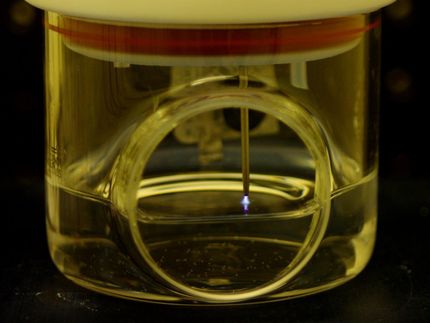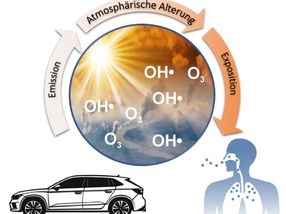The Role of Titanium in Hydrogen Storage
As part of ongoing research to make hydrogen a mainstream source of clean, renewable energy, scientists from the U.S. Department of Energy's Brookhaven National Laboratory have determined how titanium atoms help hydrogen atoms attach to an aluminum surface. Their study isolates the role of titanium, which is used as a catalyst in the crucial first step to trap hydrogen within a particular class of hydrogen-storage materials. The work may also help identify and develop similar hydrogen-storage systems.
To be a mainstream source of fuel, hydrogen must be stored safely and efficiently. Conventional high-pressure storage tanks can be dangerous and are too big and heavy for certain applications, such as hydrogen-based fuel cells in automobiles. Hydrogen-storage materials, however, incorporate hydrogen safely and compactly, and temporarily hold large quantities of it that can be recovered easily under safe, controlled conditions.
"A hydrogen-storage material must be able to store hydrogen quickly under 'normal' conditions -- that is, without very high temperatures and pressures," said Chaudhuri. "In tiny amounts, an appropriate catalyst, such as titanium, can speed up the reaction and make the hydrogen-storage process suitable for practical applications. Our study has helped us better understand the role of these catalysts."
Through this research, Chaudhuri and his collaborator, Brookhaven chemist James Muckerman, hope to improve the performance of sodium alanate, a hydrogen-storage material composed of sodium and aluminum hydride. Sodium alanate, known as a "complex metal hydride," expels hydrogen gas (the fuel) and aluminum when heated, leaving a mixture of sodium hydride and metallic aluminum. But because neither aluminum nor sodium hydride absorb hydrogen well, putting the hydrogen back in -- to reform sodium alanate and allow reuse of the material -- becomes difficult.
"We found that aluminum absorbs significantly more hydrogen -- and does so more quickly and at lower temperatures -- when a small number of titanium atoms are incorporated into its surface," Chaudhuri said.
Chaudhuri and Muckerman created a computer model that provides a plausible mechanism of the reaction. Their model agrees with an experimental x-ray absorption study of sodium alanate, performed at the National Synchrotron Light Source, a facility at Brookhaven that produces x-ray, ultraviolet, and infrared light for research.
Chaudhuri and Muckerman's collaborators at Brookhaven used x-rays to "see" and thus calculate how the titanium atoms subtly changed the atomic-level structure of the aluminum, resulting in a more hydrogen-absorbent surface. Results from these two studies agree on the role of titanium atoms on an aluminum surface and mechanisms of subsequent steps in hydrogen capture.
In the future, Chaudhuri and Muckerman's group plans to study the subsequent steps in the sodium alanate hydrogen-storage process, in which aluminum and hydrogen react with sodium hydride to reform the starting material.
This research was funded by the Office of Basic Energy Sciences within the U.S. Department of Energy's Office of Science.
Most read news
Topics
Organizations
Other news from the department science

Get the chemical industry in your inbox
By submitting this form you agree that LUMITOS AG will send you the newsletter(s) selected above by email. Your data will not be passed on to third parties. Your data will be stored and processed in accordance with our data protection regulations. LUMITOS may contact you by email for the purpose of advertising or market and opinion surveys. You can revoke your consent at any time without giving reasons to LUMITOS AG, Ernst-Augustin-Str. 2, 12489 Berlin, Germany or by e-mail at revoke@lumitos.com with effect for the future. In addition, each email contains a link to unsubscribe from the corresponding newsletter.




























































